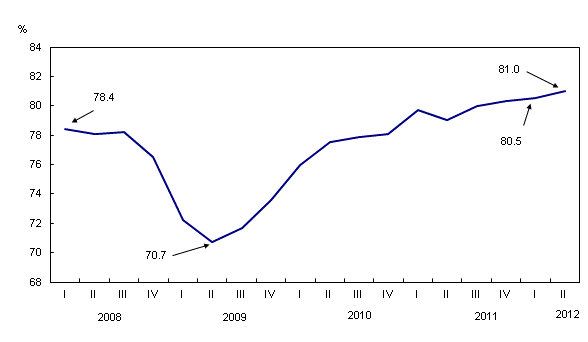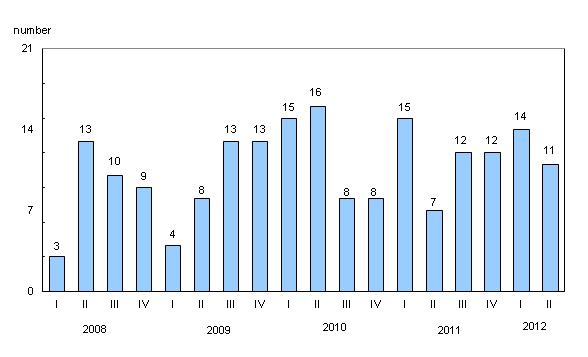Industrial capacity utilization rates, second quarter 2012
Archived Content
Information identified as archived is provided for reference, research or recordkeeping purposes. It is not subject to the Government of Canada Web Standards and has not been altered or updated since it was archived. Please "contact us" to request a format other than those available.
Related subjects
-
[an error occurred while processing this directive]
Canadian industries operated at 81.0% of their production capacity in the second quarter, up 0.5 percentage points from the previous quarter. The manufacturing and non-manufacturing sectors made comparable contributions to the increase.
The advance in the second quarter follows gains of 0.3 percentage points in the fourth quarter of 2011 and 0.2 percentage points in the first quarter of 2012.
Capacity use has increased steadily since the third quarter of 2011

Chart description: Capacity use has increased steadily since the third quarter of 2011
Manufacturing up: Major contribution from the transportation equipment and machinery industries
Capacity utilization in the manufacturing sector increased 0.5 percentage points to 81.6%.
As in the three previous quarters, the strength of the transportation equipment and machinery industries contributed significantly to the growth in capacity utilization of manufacturing industries as a whole in the second quarter.
Capacity utilization rate up in 11 of the 21 major manufacturing industries

Chart description: Capacity utilization rate up in 11 of the 21 major manufacturing industries
The capacity utilization rate was up in 11 of the 21 major manufacturing industries in the second quarter.
The largest contributors to the increase in the capacity utilization rate were the transportation equipment, machinery, wood product manufacturing and non-metallic mineral product manufacturing industries.
Capacity use was down in 10 industries, notably the computer and electronic product manufacturing industry and in the food industry.
Higher production of motor vehicles and motor vehicle parts as well as of aerospace products and their parts raised the capacity utilization rate in the transportation equipment industry by 1.9 percentage points to 91.7%.
Increased output of agricultural, construction and mining machinery and, to a lesser extent, of metalworking machinery helped push the capacity utilization rate in the machinery manufacturing industry up to 89.1%.
In the wood product manufacturing industry, capacity utilization rose from 76.1% in the first quarter to 77.9% in the second quarter. As in the previous quarter, the increase was mainly a result of higher production in the sawmills and wood preservation industry.
The non-metallic mineral product manufacturing industry operated at 81.3% of its capacity, up 3.3 percentage points. Higher production of cement and concrete products was largely responsible for the increase.
The computer and electronic product manufacturing industry ran at 85.1% of its capacity, down 2.6 percentage points. The main reason for the decline was lower production of communications equipment.
Non-manufacturing industries: Widespread small increases
The non-manufacturing sector saw an increase in its capacity utilization similar to the advance seen in the manufacturing industries as a whole.
The construction industry had the largest impact on the sector's increase, as its capacity utilization rate rose from 79.1% to 80.1% between the first and second quarter. The advance was mostly attributable to a substantial increase in engineering construction and residential building construction.
The oil and gas extraction industry also made a significant contribution to the increase in the sector's capacity utilization. The 1.3 percentage point rise in the industry's capacity utilization rate was a result of increased oil extraction, while gas extraction declined.
Higher production by potash mines and copper, nickel, lead and zinc ore mines more than offset the decline in coal extraction, resulting in a 0.2 percentage point increase in capacity utilization in the mining and quarrying industry.
Note to readers
The industrial capacity utilization rate is the ratio of an industry's actual output to its estimated potential output. For most industries, the annual estimates are obtained from the Capital and Repair Expenditures Survey, while the quarterly pattern is derived from output-to-capital ratio series, the output being the real gross domestic product at basic prices, seasonally adjusted, by industry.
This program covers all manufacturing and selected non-manufacturing industries.
At the time of this release, rates have been revised back to the first quarter of 2010 to reflect updated source data.
Available without charge in CANSIM: table CANSIM table028-0002.
Definitions, data sources and methods: survey number survey number2821.
Data on industrial capacity utilization rates for the third quarter will be released on December 13.
For more information, or to enquire about the concepts, methods or data quality of this release, contact Statistics Canada's National Contact Centre (toll-free 1-800-263-1136; 613-951-8116; infostats@statcan.gc.ca) or the Media Hotline (613-951-4636; statcan.mediahotline-ligneinfomedias.statcan@canada.ca).
- Date modified:
